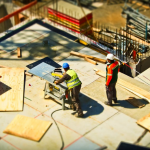Climate change brings with it an increase in severe storms and rainy weather. Is your yard flooding after every rainstorm? Is it a better duckpond than dog run or kids play area?
Rainwater collecting in your yard can cause serious damage to the yard and your home. If you don’t fix your drainage issues, you could end up with a flooded basement!
If you’ve got water drainage issues, keep reading for how to drain a flooded yard. We’ll offer you three smart strategies to get the flooding under control.
1. A Drainage Leach Field
Overwatering plants is as bad as underwatering them. If your yard is often underwater from rainstorms or other problems, take care of it quickly so it doesn’t kill your landscape.
A drainage leach field may be the perfect solution. This system relocates the water to the sewer system or a low point in the yard.
The system includes digging a large drainage ditch that holds a pipe. Gravel goes on top of the pipe system. This relocates the water to a more appropriate place.
The leach field also includes connecting sump pumps into redirected downspouts. Click here for more information.
2. Yard Grading
When it comes to draining a flooded yard, sometimes grading is your best option. A properly sloped yard runs away from the house at a two-percent grade. This keeps the water away from the home’s foundation.
Your yard may not have been graded correctly from the start, or it may have eroded over time. Either way, if the yard doesn’t slope away from the house at the right angle, yard grading may be the best fix.
A 2% grade is about a half-inch slope downward per 10 feet. If there aren’t 10 feet of land between the house and the edge of the yard, you may need drains.
It’s possible your yard doesn’t need an entire grading. Soil elevation may also work.
Add topsoil or mulch to the area where water collects. This evens out the yard and may work, though it may not be enough. You may also find yourself adding more soil and mulch to the point it’s not the cost-effective option you wanted.
3. Sump Pumps
Sump pumps keep water out of the yard, basements, and crawlspaces. The pump drains the water through a hose out to an appropriate place.
The sump pump sits in a ditch and comes on automatically when the area fills with water. Sump pumps are an expensive but effective option for many situations.
Now You Know How to Drain a Flooded Yard
There are many ways of answering the question of how to drain a flooded yard. These are three different strategies that work well depending on the situation.
The reason for flooding is different for every yard, so it’s best to call in an expert if possible. Paying for an expert is better than dealing with a flooded house because you didn’t do the job right yourself!
Looking for more home improvement articles? Check out the rest of our blog!



